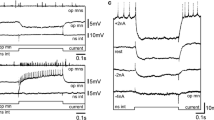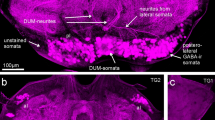Summary
-
1.
The branchial ganglion of the gills ofAplysia kurodai, A. juliana andDolabella auricularia were investigated, using electrophysiological techniques.
-
2.
The branchio-ganglionic neurons (BGNs) generated spontaneous tonic impulses with superimposed pacemaker potentials and mainly periodic bursting impulses superimposed on slow sustained depolarizing potentials.
-
3.
BGNs were synchronously active, coupled one to another through bidirectional electrical synapses.
-
4.
Electrical stimulation of the branchial nerve elicited excitatory postsynaptic potentials (EPSPs), in BGNs, which showed facilitation and summation and were blocked with high Mg2+ sea water, indicating that the EPSPs were chemically mediated.
-
5.
Electrical stimulation of a nerve extending posterior to the ganglion also produced EPSPs in BGNs. These EPSPs showed summation (but not facilitation), and were blocked with high Mg2+ sea water, indicating that the EPSPs were chemically mediated.
-
6.
Tactile stimulation to the pinnule exerted excitatory transmission of EPSPs which caused BGNs to fire a burst of impulses, and resulting in a reflexive pinnule contraction.
-
7.
Electrical stimulation applied to a nerve of the branchial ganglion produced inhibitory postsynaptic potentials (IPSPs) which showed summation and had a reversal potential at a level slightly higher than the resting membrane potential. The inhibitory transmission seems to be from the mechanoproprioceptor in the gill, since it was elicited by a spontaneous gill contraction or by perfusion of the branchial vasculature with sea water.
-
8.
When either spontaneous bursts of the BGNs occurred, or bursts of BGNs were induced by intracellular current application, EJPs were evoked in the pinnule muscle. Thus, the peripheral nervous system including the branchial ganglion may contain motor neurons of the pinnule muscle.
-
9.
The branchial ganglion had functions of the peripheral reflex center and the distributing center of central motor influence to the branchial muscle.
Similar content being viewed by others
Abbreviations
- BGN :
-
branchio-ganglionic neuron
References
Bailey CH, Castellucci VF, Koester J, Kandel ER (1979) Cellular studies of peripheral neurons in siphon skin ofAplysia californica. J Neurophysiol 42:530–557
Byrne JH, Koester J (1978) Respiratory pumping: Neuronal control of a centrally commanded behavior inAplysia. Brain Res 143:87–105
Byrne J, Castellucci VF, Kandel ER (1974) Receptive fields and response properties of mechanoreceptor neurons innervating siphon skin and mantle shelf inAplysia. J Neurophysiol 37:1041–1064
Carew TJ, Kandel ER (1977) Inking inAplysia californica. I. Neural circuit of an all-or-none behavioral response. J Neurophysiol 40:692–707
Carew TJ, Pinsker H, Rubinson K, Kandel ER (1974) Physiological and biochemical properties of neuromuscular transmission between identified motoneurons and gill muscle inAplysia. J Neurophysiol 37:1020–1040
Carew TJ, Castellucci VF, Byrne JH, Kandel ER (1979) Quantitative analysis of relative contribution of central and peripheral neurons to gill-withdrawal reflex inAplysia californica. J Neurophysiol 42:497–509
Eales NB (1921)Aplysia. LMBC Memoirs XXIV, Liverpool
Fiore L, Meunier JM (1979) Synaptic connections and functional organization inAplysia buccal ganglion. J Neurobiol 10:13–29
Frazier WT, Kandel ER, Kupfermann I, Waziri R, Coggeshall RE (1967) Morphological and functional properties of identified neurons in the abdominal ganglion ofAplysia californica. J Neurophysiol 30:1288–1351
Jacklet JW, Rine J (1977) Facilitation at neuromuscular junctions: Contribution to habituation and dishabituation of theAplysia gill withdrawal reflex. Proc Natl Acad Sci USA 74:1267–1271
Kandel ER, Frazier WT, Waziri R, Coggeshall RE (1967) Direct and common connections among identified neurons inAplysia. J Neurophysiol 30:1352–1376
Koester J, Kandel ER (1977) Further identification of neurons in the abdominal ganglion ofAplysia using behavioral criteria. Brain Res 121:1–20
Koester J, Mayeri E, Liebeswar G, Kandel ER (1974). Neural control of circulation inAplysia. II. Interneurons. J Neurophysiol 37:476–496
Kupfermann I, Kandel ER (1969) Neuronal controls of a behavioral response mediated by the abdominal ganglion ofAplysia. Science 164:847–850
Kupfermann I, Kandel ER (1970) Electrophysiological properties and functional interconnections of two symmetrical neurosecretory clusters (bag cells) in abdominal ganglion inAplysia. J Neurophysiol 33:865–876
Kupfermann I, Pinsker H, Castellucci V, Kandel ER (1971) Central and peripheral control of gill movements inAplysia. Science 174:1252–1256
Kupfermann I, Carew TJ, Kandel ER (1974) Local, reflex, and central commands controlling gill and siphon movements inAplysia. J Neurophysiol 37:996–1019
Kuwasawa K (1967) Transmission of impulses from the cardiac nerve to the heart in some molluscs (Aplysia andDolabella). Sci Rept Tokyo Kyoiku Daigaku Sect B 13:111–128
Lukowiak K (1980) CNS control over gill reflex behaviors inAplysia: Satiation causes an increase in the suppressive control in older but not young animals. J Neurobiol 11:591–611
Lukowiak K, Peretz B (1977) The interaction between the central and peripheral nervous systems in the mediation of gill withdrawal reflex behavior inAplysia. J Comp Physiol 117:219–244
Mayeri E, Koester J, Kupfermann I, Liebeswar G, Kandel ER (1974) Neural control of circulation inAplysia. I. Motoneurons. J Neurophysiol 37:458–475
Peretz B (1969) Central neuron initiation of periodic gill movements. Science 166:1167–1172
Peretz B (1970) Habituation and dishabituation in the absence of a central nervous system. Science 169:379–381
Peretz B, Estes J (1974) Histology and histochemistry of the peripheral neural plexus in theAplysia gill. J Neurobiol 5:3–19
Peretz B, Howieson DB (1973) Central influence on peripherally mediated habituation of anAplysia gill withdrawal response. J Comp Physiol 84:1–18
Peretz B, Moller R (1974) Control of habituation of the withdrawal reflex by the gill ganglion inAplysia. J Neurobiol 5:191–212
Peretz B, Jacklet JW, Lukowiak K (1976) Habituation of reflexes inAplysia: Contribution of the peripheral and central nervous systems. Science 191:396–399
Perlman AJ (1979) Central and peripheral control of siphonwithdrawal reflex inAplysia californica. J Neurophysiol 42:510–529
Tritt SH, Byrne JH (1980) Motor controls of opaline secretion inAplysia californica. J Neurophysiol 43:581–594
Author information
Authors and Affiliations
Rights and permissions
About this article
Cite this article
Kurokawa, M., Kuwasawa, K. Electrophysiological studies on the branchial ganglion in the opisthobranch molluscs (Aplysia andDolabella). J. Comp. Physiol. 156, 35–44 (1985). https://doi.org/10.1007/BF00610664
Accepted:
Issue Date:
DOI: https://doi.org/10.1007/BF00610664




